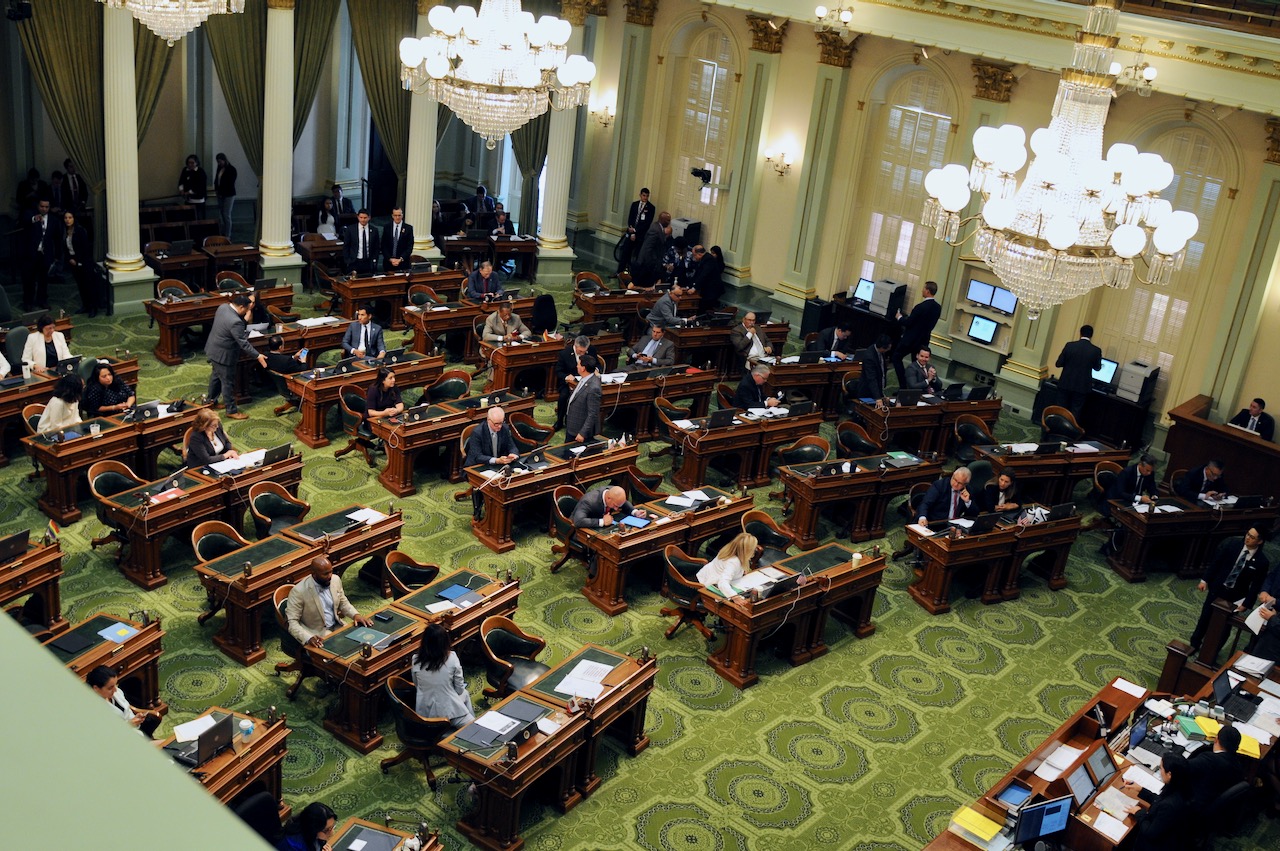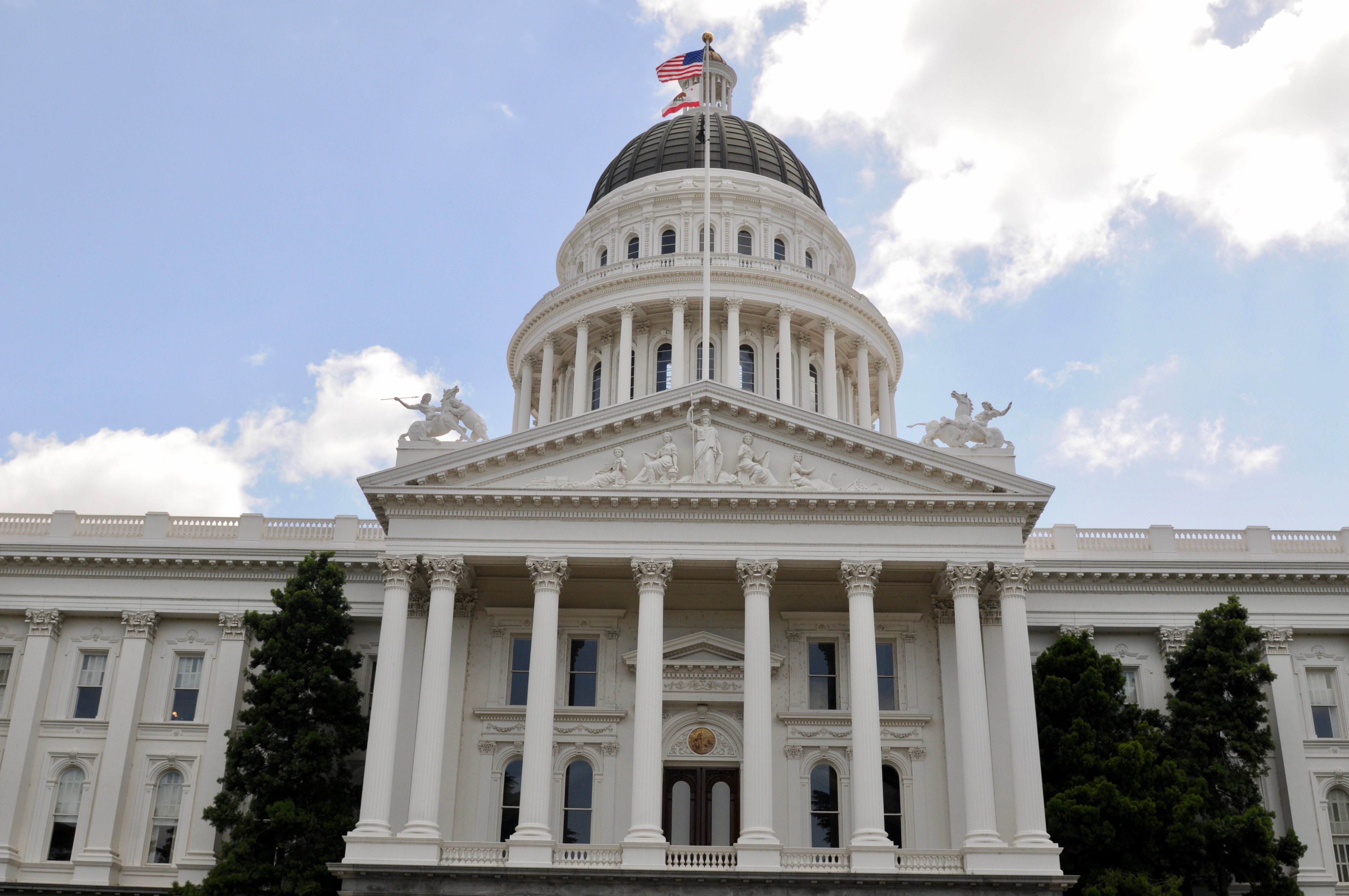
California Bear Flag. (Photo: ca.gov)
Dissecting California Legislation
What to look for in a bill
By Chris Micheli, February 17, 2020 6:37 am
As part of the California legislative process, there are several types of measures that can be considered by legislators. Let’s take a closer look:
Types of Measures
There are three types of measures considered by the California Legislature:
Bills
All bills, constitutional amendments and resolutions must be printed by the Office of State printing and be made available to legislators, staff and the public, which is usually the next day online and at the Bill Room in the basement of the old section of the State Capitol.
Generally, no bill (except the Budget Bill) may be heard by any committee or acted upon by either house until the 31st day after the bill is in print. This requirement can be waived with a three-fourths vote of the house of origin.
Bills must be passed by both houses of the Legislature and be signed into law by the Governor (unless he or she allows the bill to become law without his or her signature) in order to take effect. Statutes can only be enacted through bills.
Constitutional Amendments
The Legislature may place measures on the statewide ballot for a vote by the people. These proposed Constitutional Amendments are ACAs (for those introduced in the Assembly) or SCAs (for those introduced in the Senate). Constitutional amendments proposed by the Legislature require a two-thirds majority vote of each house for passage (rather than the standard majority vote). Also, these measures are not sent to the Governor for signature or veto. Instead, they are placed on the next statewide ballot for a vote of the people.
If a majority of the statewide voters support the ballot measure, then the changes or additions become a part of the California Constitution. All constitutional amendments are referred to the policy standing committee having jurisdiction of that subject matter and, upon being reported out of that committee, are then re-referred to the committee having constitutional amendments within its jurisdiction. ACAs and SCAs may also be heard by the fiscal committees in each house prior to reaching the respective floors of the Assembly or Senate.
Resolutions
There are three types of resolutions that can be considered by the Assembly and Senate. One is used by either house individually (i.e., it only passes a single house in order to take effect), while the other two (concurrent resolutions and joint resolutions) require adoption by both houses of the Legislature before they can take effect.
House Resolutions (the term used in the Assembly) and Senate Resolutions are adopted by the house of origin only. All resolutions require a majority vote to pass and they are not subject to deadlines or waiting periods. As such, they may be acted upon in short order.
Joint resolutions are used for matters related to the federal government. They express a position of the California Legislature regarding pending congressional legislation. Joint resolutions take effect upon their being filed with the Secretary of State.
Concurrent resolutions are used for matters to be handled by both houses of the Legislature. They are used to create joint committees of the Legislature, memorialize former legislators, and for other limited purposes. Concurrent resolutions take effect upon their being filed with the Secretary of State.
Types of Bills
The following are the types of bills that people working in and around the State Capitol describe in their legislative dealings:
Appropriation bill – this bill contains language that appropriates funds for expenditures by the state
Author-sponsored bill – this bill is the idea of the author, who is the official sponsor
Backed bill – this bill is ready for introduction because it has a “backing” (formally called a jacket) that shows who the author is
Budget bill – this bill is the main budget bill that makes appropriations for implementation of the state’s fiscal year spending (the secondary bill is referred to as the “budget bill junior”)
Clean-up bill – this bill “cleans-up” changes to a law following enactment of a prior bill that needs to be modified
Committee bill – this bill is authored by a majority of a committee; usually used for enacting non-controversial law changes
District bill – this bill only applies to the legislator’s own district, such as benefiting his or her transit district
Fiscal bill – this bill must go through the fiscal committee after it has passed the policy committee
Intent bill – this bill makes a statement of intent of the Legislature that the bill will do something on a topic specified in the intent statement; it is a placeholder for a later bill
Omnibus bill – this bill is a measure that contains numerous changes to the law, generally suggested by a group, such as civil law changes recommended by the Judicial Council
Special interest bill – this bill has a sponsor that is a particular interest group
Sponsored bill – this bill came from an interest group or individual as the sponsor
Spot bill – this bill makes a technical, non-substantive change in the law as a placeholder for a later bill; neither house’s rules committee will refer spot bills to a policy committee until they are substantively amended
Technical corrections bill – this bill makes a technical correction in the law
Trailer bill – this bill implements statutory changes as part of the budget adoption; these bills “trail” the main budget bill
Two-year bill – this bill carries over from the first year of session into the second year of the session
Unbacked bill – this bill does not yet have an author and no “backing” for introduction
Provisions of a Bill
The following are the provisions of a bill introduced in the Assembly or Senate:
- The amendment date(s) are listed at the top of the first page.
- Followed next is the bill number.
- The principal author is listed next and, if there are coauthors of the bill, then their names are listed under the bill’s author in alphabetical order (there can also be principal co-authors of a bill).
- Next comes the date that the bill was introduced.
- The next provision is the title which indicates the code section(s) the bill is affecting and contains a relating clause.
- Legislative Counsel’s Digest follows next and is a brief summary of the existing law and the changes the bill proposes to make to that existing law(s). The Digest is found on the front of each bill.
- Vote keys are part of the Digest. They identify the vote required to pass the bill, whether the bill makes an appropriation, whether the bill will be heard in the fiscal committee, and whether the bill contains a state-mandated local program.
- The Enacting Clause is contained in each bill pursuant to statute that provides “The People of the State of California do enact as follows.”
- Finally, the actual bill language that will become law if the bill is adopted follows. Note that the bill contains strikeout text, which indicates that words are being deleted, while italicized words indicate new provisions in the bill.
Amendments to Bills
A bill either proposes a new law or amends or repeals an existing law. The Constitution provides that every act can only embrace one subject and that subject must be expressed in the title of the measure (this is the so-called “single subject rule”). The courts have been very liberal in their construction of what must be contained in the title of a bill.
Under the Joint Rules of the Assembly and Senate, the title of every bill introduced must convey an accurate idea of the contents of the bill and must indicate the scope of the act and the object to be accomplished. In amending a code section, the mere reference to the section by number is not deemed sufficient to meet this rule.
A bill amending more than one section of an existing law must contain a separate section for each section of the code amended. Bills that are not amendatory of existing laws are divided into short sections, where this can be done without destroying the sense of any particular section, to the end that future amendments may be made without the necessity of setting forth and repeating sections of unnecessary length.
Under the Joint Rules, a bill may not be introduced unless it is contained in a cover (called the “jacket”) attached by the Legislative Counsel and it is accompanied by a digest, prepared and attached to the bill by the Legislative Counsel, showing the changes in the existing law that are proposed by the bill. A bill may not be printed where the body of the bill or the Legislative Counsel’s Digest has been altered, unless the alteration has been approved by the Legislative Counsel. The digest must be printed on the bill as introduced, commencing on the first page.
Under the Joint Rules, whenever a bill is amended in either house, the Secretary of the Senate or the Chief Clerk of the Assembly must request the Legislative Counsel to prepare an amended digest and cause it to be printed on the first page of the bill as amended. The digest must be amended to show changes in the existing law that are proposed by the bill as amended, with any material changes in the digest indicated by the use of appropriate type.
Under the Joint Rules, in a bill amending or repealing a code section or a general law, any new matter is underlined, and any matter to be omitted is in type bearing a horizontal line through the center and commonly known as “strikeout” type. When printed, the new matter is printed in italics, and the matter to be omitted is printed in “strikeout”.
In an amendment to a bill that sets out for the first time a section being amended or repealed, any new matter to be added and any matter to be omitted is indicated by the author and is printed in the same manner as though the section as amended or repealed was a part of the original bill and was being printed for the first time.
When an entire code is repealed as part of a codification or recodification, or when an entire title, part, division, chapter, or article of a code is repealed, the sections comprising the code, title, part, division, chapter, or article are not set forth in the bill or amendment in strikeout type.
Urgency bills require an urgency clause which consists of a statement of the facts constituting the necessity for its immediate effect. The facts constituting an urgency require that they be related to and necessary for the immediate preservation of the public peace, health or safety. Such a statute may not have an immediate effect unless the urgency section and the bill each receive, upon a separate rollcall vote entered in the Daily Journals, a two-thirds vote of the membership of both houses.
Under the Joint Rules, a bill may not add a short title that names a current or former Member of the Legislature. In addition, a bill or resolution may be authored only by a Member or committee of the house of origin. Members or committees that are not of the house of origin may be “principal coauthors” or “coauthors.” A bill may not indicate in its heading or elsewhere that it was introduced at the request of a state agency or officer or any other person. A bill may not contain the words “By request” or words of similar import.
What to Look for in a Bill
The text of a bill provides valuable information on a variety of aspects about a piece of legislation. By looking at information such as the bill type, the author, the introduction date, title, the digest, and the actual proposed law, you can tell a lot about the journey the bill will take through the Legislature.
Authors and Co-authors
Knowing the authors and co-authors provides you with information on who to contact in support of or opposition to the bill. Also knowing information about the author, such as his or her background, committees serving on, political party, and political clout can allow you to predict the success of the measure.
Introduction Date
The introduction date tells you when to expect action to begin. Bills must be in print for 30 days before any action can be taken (unless the rule is waived by the house). This allows interested parties time to prepare information on these bills, working with authors on amendments, complaints or suggestions.
Title
The title identifies the sections of law that are affected by the bill. These sections inform you of the status of existing law and let you know how the existing law will be changed by this bill. These sections can also serve as a key to other bills affecting the same area, as well as aid in determining which policy committee a bill may be referred to.
Legislative Counsel’s Digest
The Legislative Counsel prepares a nonpartisan summary of each piece of legislation. This summary may act as a short cut for screening bills. Also provided at the end of the Digest are important pieces of information (called the “keys”) such as whether the bill has a fiscal impact, an appropriation, contains an urgency clause, the vote requirements for the bill, and whether or not the bill includes a state-mandated program.
Actual Text
Keep in mind that every time a bill is amended, a new version of the bill will be printed. Any text that has been deleted from the previous version will be in strikeout type and any new text will be in italics. Remember that the changes reflect only those changes from the previous version — not the introduced version. Check the top of the bill in order to be sure you have the most recent version of the bill. You can also check the History for the most recent amendment date.
- Frequently Asked Questions about When Elected Officials Take Office - April 25, 2024
- Frequently Asked Questions About Ethics Training for Local Agencies - April 24, 2024
- Frequently Asked Questions about Privileges of Voters in California - April 23, 2024




